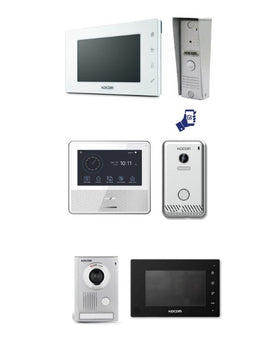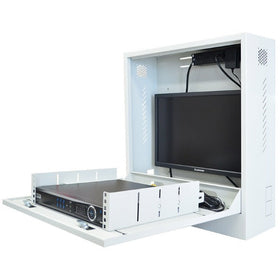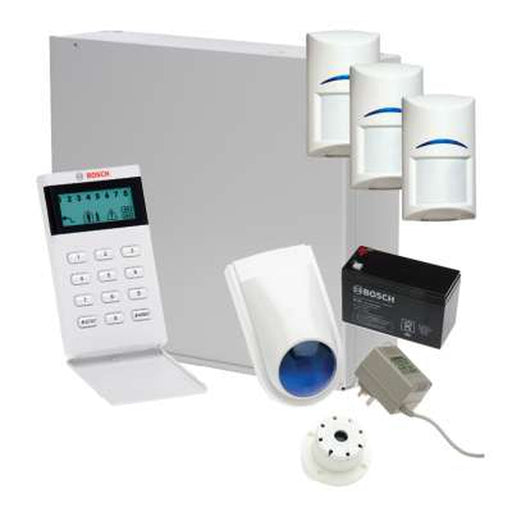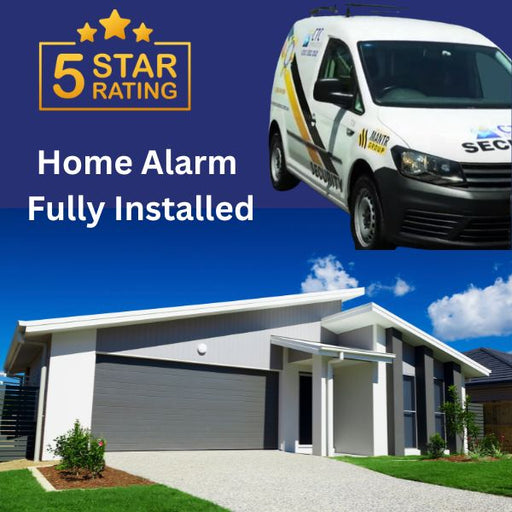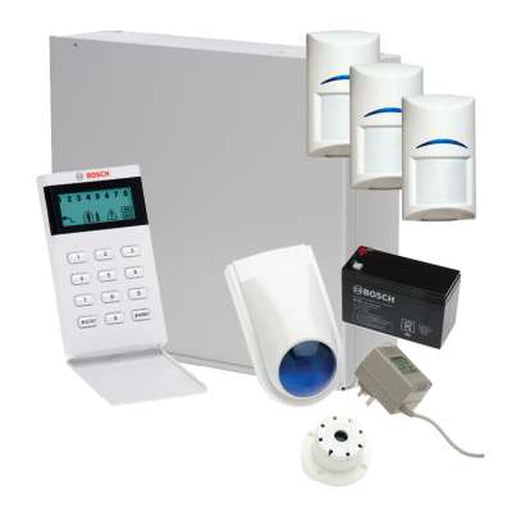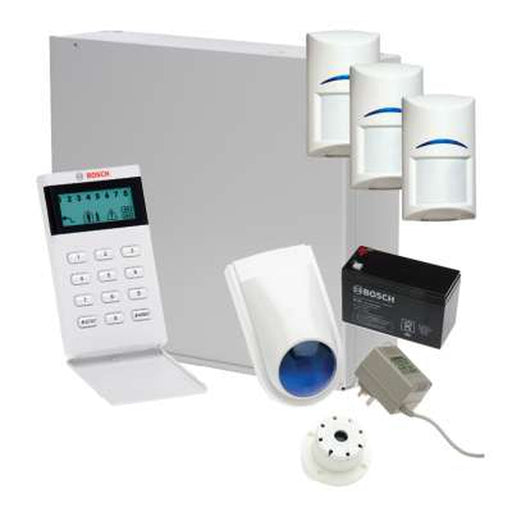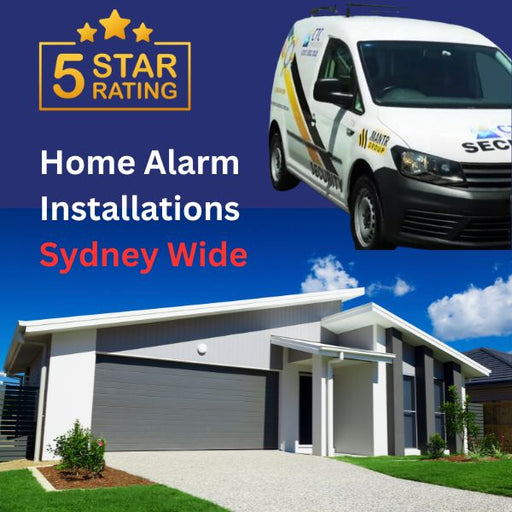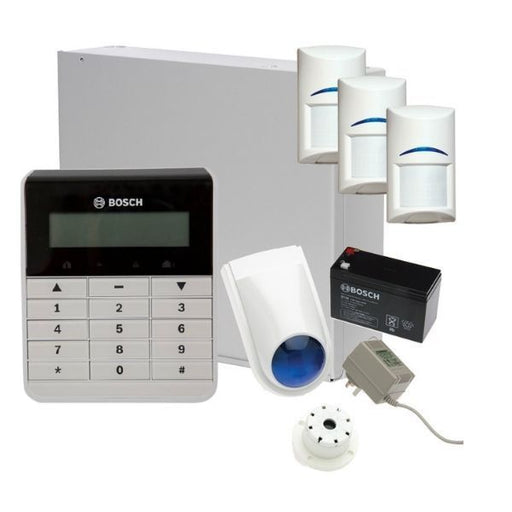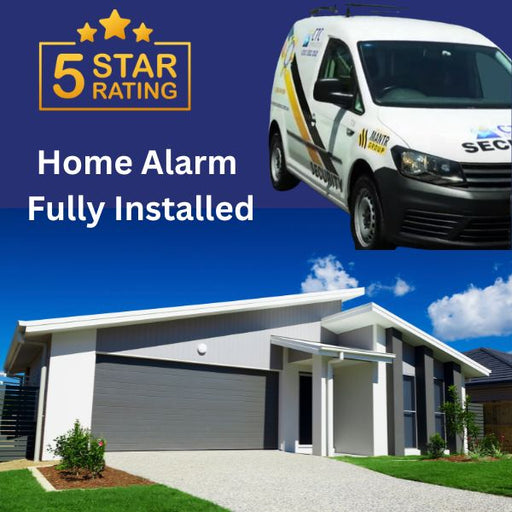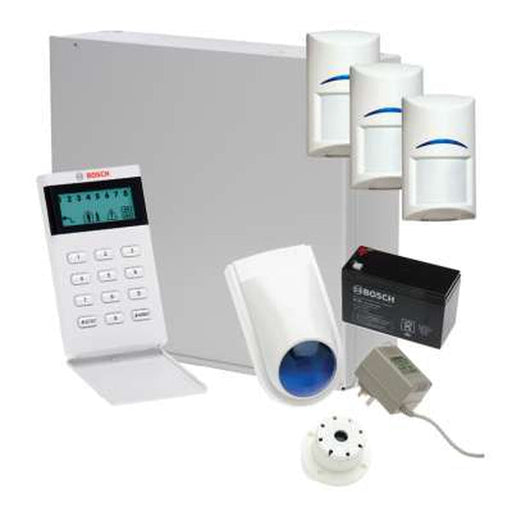Frequently Asked Questions
A home alarm system (security alarm) is a set of devices and technologies designed to detect unauthorised entry into a home and alert the homeowner or monitoring service to potential security threats.
How does a home alarm system work?
A home alarm system typically includes sensors on doors and windows, motion detectors, and a control panel. When a sensor is triggered, the system sends an alert to the control panel, which then activates an alarm and/or sends a notification to the homeowner or monitoring service.
Generally the selection of the alarm system is in line with the Budget and Size of the premises to be protected.
Typically most domestic system will have standard 8 Input connections for Motion Detectors (PIRs) and Reed Switches.
Depending on the type this number can be doubled by the use of resistors and wiring. Each alarm system has its limitations on how many inputs can be connected, if they exceed the onboard capacities then expansion panels can be added to the system to increase the inputs and outputs.
Various motion sensors connect to the control panel from locations throughout your home.
If your security system is armed and the sensors detect a problem, they send signals to the control panel. The control panel automatically dials the central monitoring station or your mobile, where the proper authorities are notified.
In some systems like the Bosch 3000 and 6000 it can also send an SMS to your mobile with text information on what is happening on your system.
Check out our full range of Smartphone Alarm Systems.
Many modern alarm systems offer integration with smart home devices such as smart locks, lights, thermostats, and security cameras, allowing for a more comprehensive and interconnected home security solution.
Numerous leading brands offer CCTV integration and an extensive range of accessories.
Common alarm sensors include door/window sensors, motion detectors, glass break sensors, and environmental sensors (e.g., smoke, carbon monoxide, and flood detectors).
Check out our full range of alarm accessories.
A duress button is used to trigger either silent or sirens when pressed to alert authorities, neighbours or family members that the person who pressed it is in trouble or fear of their life.
Duress buttons are typically installed in a discrete location out of the way of children and in an accessible location.
Some duress buttons can be worn by elderly.
Hikvision offers diverse wearable duress buttons, align with CCTV motion sensors for elder self-monitoring.
Do they really work well, and are they easy to use?
Yes on both counts! Technological breakthroughs have led to the development of wireless electronic security products, and their effectiveness has been proven time and again over the years in millions of installations. Their rock-solid stability and long battery life make them a popular choice among homeowners and dealers alike. They give installers the flexibility they need to overcome obstacles like brick walls, cement floors and cathedral ceilings; and no drilling holes preserves the beauty of your home and results in cleaner, faster installations.
Folks today enjoy the convenience of remote control devices, and the security industry has responded! User-friendly wireless products provide the dual benefits of superior performance and ease of operation. Wireless keypads allow you to activate and de-activate your security system with the touch of a button, and can even be programmed so that a young child can operate it with ease.
Homeowners especially love wireless keys! Similar in size to a remote car alarm key, they fit right on your keychain, and the press of a single button lets you control your system, lights and appliances-eliminating the need for codes. This is especially great if you and your family enjoy spending time outdoors. Relax by the pool, garden, barbecue and entertain, or play with your kids in the backyard-enjoy extra mobility without compromising your safety!
The down side is wireless motion detection uses batteries and these will need to be changed every 12 Months or so, depending upon the battery type or when they run flat. The wireless alarm system will alert to low battery mode.
Installation and Set up
Some alarm systems are designed for DIY installation, while others may require professional installation to ensure optimal performance and security.
It often depends on the complexity of the system and your comfort level with the installation process.
The Hikvision Wireless Alarm system can be installed DIY.
All other home alarm systems we recommend using an authorised installer.
CTC Communications offer alarm installation services Sydney Wide.
Installation times can vary based on the complexity of the system and the size of the property.
DIY installations might take a few hours, while professional installations could take a day or more.
For new home builds we recommend pre-cabling the alarm system during construction.
Monitoring and Alerts
Professional monitoring involves a third-party service that watches over your alarm system 24/7.
If an alarm is triggered, the monitoring center will contact you and/or emergency services. While not necessary, professional monitoring can provide an additional layer of security.
- Basic alarm, code pad, panel, motion sensors and internal & external sirens, if your alarm system is triggered the external and internal sirens will be activated, you this will alert nearby residents and scare off intruders, when you arrive home the external siren light will be flashing.
- Smartphone Alarms, Notifications can be sent via phone calls, text messages, emails, or push notifications through a mobile app, depending on the system's capabilities and your preferences. Check out our range of Smartphone alarms.
- Monitoring Service, if your alarm is connected to this service, they will send a Patrol car to your premise if this is in your preferences.
Motion Detectors & Reed Switches
A passive infrared motion detector (PIR) is an electronic security device that detects intruders by "sensing" motion or body heat in the area being protected. Most PIRs are designed to be used when your family is away from home or when no one will be passing through the area "covered" by the PIR.
Magnetic contacts are two-part devices used to safeguard windows and doors. One part of the contact is a switch installed in the window or door jam; the other contains a magnet and is placed in the window or door itself. Any noticeable shift in contact with the switch results in an alarm. Reed Switches as they are often called can be either recessed or flush mounted.
A Reed Switch is an expensive addition to an established house as cabling to windows and doors is labour intensive and difficult.
Dual Tech Motion Sensor
A passive infrared motion detector (PIR) is an electronic security device that detects intruders by "sensing" motion or body heat in the area being protected. Most PIRs are designed to be used when your family is away from home or when no one will be passing through the area "covered" by the PIR.
Tri Tech Motion
The term Tri Tech is short for Tri Technology. It uses a combination of Passive Infrared, Microwave and advanced signal processing to trigger an alarm. Typically Tri Tech sensors are used to cover larger areas and for harsher environments.
What is Pet Friendly Anyway?
Recent innovations in security technology have resulted in the creation of "pet immune" motion detectors-allowing dog and cat lovers to enjoy the same level of protection they would receive with a standard PIR. These state-of-the-art sensors provide "pet immunity" for animals weighing up to 100 lbs. Pet immune PIRs allow your pet to move about freely but can still detect an intruder’s movement.
Effective in deterring Break Ins prior to their occurrence
"Acoustic" glass break sensors, usually mounted on ceilings or walls, work by "listening" for the sound of breaking glass in a window. "Shock" glass break detectors are mounted on the window and "feel" the shock of breaking glass. This kind of advanced wireless technology can provide shatter and shock protection for your windows, for often intruders are "sensed" and an alarm sounded while they are still outdoors. This is often enough to send a burglar running!
As a smoke detector owner, you understand the crucial safety role this device plays.
Smoke detectors are highly effective in preventing loss of life and property.
However, there are differences between the "stand alone" or battery-operated smoke detector you would buy at your local hardware store and one installed as part of your home security system.
"Stand alone" detectors are not connected to other detectors or warning devices. A smoke detector connected to your security system offers more protection because it is monitored by a central station. If fire strikes, the detector sets off an alarm and sends a signal to the control panel.
The control panel dials the central station, where the operator notifies the fire department.
Only central station monitored smoke detectors provide automatic notification of authorities when you or your family are asleep, not at home or unable to get to the phone.
The Backup Battery thwarts attempts to cut power to your premises, ensuring the alarm system remains functional.
Battery backup is there for when your system loses the supply from the energy provider.
The backup battery should last at minimum 3 hours realistically. Most manufacturers state that it will last 7.5 hours but that would be under no load or very little connections.
Maintenance & Troubleshooting
Regular maintenance includes testing the system, replacing batteries in sensors and control panels, and updating software or firmware.
It's also important to keep sensors clean and free from obstructions.
The standard AS2201.1 states that the alarm battery should be changed at least once a year.
If your panel doesn’t use the battery due to no power outages this is a good idea.
If the battery is used more for prolonged periods than at the end of the event the battery should be changed.
If you encounter issues, consult the user manual for troubleshooting steps.
If we have installed your alarm system please contact us for after sales support on 1300 552 282.
CTC offers alarm servicing Sydney Wide.
Check out our Troubleshooting Guide.
Can I troubleshoot my alarm system on my own?
Why is my alarm system beeping?
How do I silence a beeping alarm system?
What should I do if my alarm system keeps false alarming?
How to change master code
Deleting a pin number Alarm System
Changing mobile number for SMS notification
How often should I test my alarm system?
What should I do if my alarm system shows a trouble or fault indicator?
How do I reset my alarm system after a power outage?
What should I do if my alarm system's keypad is not responding?
Costs and Contracts
Costs can vary widely depending on the type and complexity of the system.
Basic 3 sensor system can start around $400, supply only.
Basic DIY system Wireless $434.50
Both system have a huge range of expandable accessories.
Security System Installed Sydney Wide from $900.
Alarm.Com offers a fully installed system with self monitoring on a monthly fee, Request A Quote for Pricing.
While professionally installed systems with advanced features can cost several thousand dollars. Monitoring services typically charge a monthly fee.
Alarm.Com offers a fully installed system with self monitoring on a monthly fee, Request A Quote for Pricing.
- Hikvision
- DSC
- Bosch
All have Smartphone App, the Bosch 6000 has subscription service for self monitoring, called the IFob.
Residential & Commercial 24/7 Alarm Monitoring
Enjoy peace of mind knowing that your home is secure and any emergencies will be managed quickly as soon as they arise.
Permacon PM 45 Communicators
- P2U GPRS (Unsupervised Open and Closing Signals) $38.00 Plus GST
- P2S GPRS (Supervised Open and Closing Signals) $39.00 Plus GST
- P8U IP – GPRS (Unsupervised Open and Closing Signals) $38.00 Plus GST
- P8S IP – GPRS (Supervised Open and Closing Signals) $42.00 Plus GST
- P9U GPRS – GPRS (Unsupervised Open and Closing Signals) $40.00 Plus GST
- P9S GPRS – GPRS (Supervised Open and Closing Signals) $45.00 Plus GST
Multicom
- P2 12 Hour (Single Sim) $38.00 Plus GST (Unsupervised Open and Closing Signals)
- P2 12 Hour (Single Sim) $39.00 plus GST (Supervised Open and Closing Signals)
- P3 12 Hour (Dual Sim) $37.00 Plus GST (Unsupervised Open and Closing Signals)
- P3 12 Hour ( Dual Sim) $46.00 Plus GST (Supervised Open and Closing Signals)
- P12 120 Second Poll (Single Sim) $44.00 Plus GST (Unsupervised Open and Closing Signals)
- P12 120 Second Poll (Single Sim) $51.00 Plus GST (Supervised Open and Closing Signals)
- P14 120 Second Poll (Dual Sim) $50.00 Plus GST (Unsupervised Open and Closing Signals)
- P14 120 Second Poll ( Dual Sim) $59.00 Plus GST (Supervised Open and Closing Signals)
Fully installed alarm system with back to base monitoring
Bosch Solution 6000 Alarm + Back to Base Monitoring Deal
Current price $1,750.00
Alarm Installation Specials | Sydney Wide
-
 Featured Collection
Featured Collection -
Best Value Bosch Alarm System Fully Installed | Western Sydney
BoschOriginal price $900.00 - Original price $900.00Original price$900.00$900.00 - $900.00Current price $900.00Best Value Bosch Alarm System Fully Installed | Western Sydney Wide CTC Communications is the trusted name in Home Alarm Installations, installi...
View full detailsOriginal price $900.00 - Original price $900.00Original price$900.00$900.00 - $900.00Current price $900.00 -
Bosch Solution 2000 Alarm System Fully Installed | Best Value
BoschOriginal price $0.00 - Original price $0.00Original price $0.00$900.00$900.00 - $900.00Current price $900.00Bosch Solution 2000 Alarm System Fully Installed | Best Value complete with a 3-year manufacturer warranty. CTC Communications has over 25 years o...
View full detailsOriginal price $0.00 - Original price $0.00Original price $0.00$900.00$900.00 - $900.00Current price $900.00 -
Bosch Alarm Fully Installed Sydney Wide | Single Storey Home Installation
BoschOriginal price $940.00 - Original price $940.00Original price$940.00$940.00 - $940.00Current price $940.00Bosch Home Alarm System Fully Installed | Sydney Metro Area With a range of customization available to suit your home and lifestyle, this alarm sys...
View full detailsOriginal price $940.00 - Original price $940.00Original price$940.00$940.00 - $940.00Current price $940.00 -
Bosch Home Alarm System Fully Installed | Solution 2000
BoschOriginal price $950.00 - Original price $950.00Original price$950.00$950.00 - $950.00Current price $950.00Bosch Home Alarm System installation package, Solution 2000 is fully installed by CTC Communications. The home alarm system is tailored for a sing...
View full detailsOriginal price $950.00 - Original price $950.00Original price$950.00$950.00 - $950.00Current price $950.00 -
Bosch Solution 3000 Alarm System | Fully Installed | Western Sydney
BoschOriginal price $950.00 - Original price $950.00Original price$950.00$950.00 - $950.00Current price $950.00Professional installation of Bosch Solution 3000 Alarm System for a Single Storey Home in Western Sydney Area. Kit Contents In the Bosch Solution...
View full detailsOriginal price $950.00 - Original price $950.00Original price$950.00$950.00 - $950.00Current price $950.00
Learn More
-

A Perfect Solution for Elderly Care | Hikvision AX Pro Wireless Alarm
Read nowThe Hikvision AX Pro Wireless Alarm offers advanced solutions for elderly safety with features like wireless single and dual-button panic buttons, the versatile wall-mounted panic button, and the emergency button wristband accessory. Designed for discretion and reliability, these devices ensure help is always within reach.
-

How to Maintain and Test Your Security Alarm System: Practical Tips for Optimal Performance
Learn how to maintain and test your security alarm system with these practical tips. Ensure optimal performance, avoid false alarms, and keep your property protected. CTC Communications offers expert advice and maintenance services for reliable security.Read now -

Why Monitoring Services are Critical for Home Security
Discover why professional monitoring services are essential for home security. Ensure rapid emergency response, round-the-clock protection, and potential insurance discounts for ultimate peace of mind.Read now

